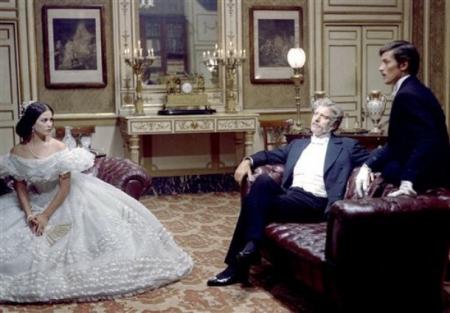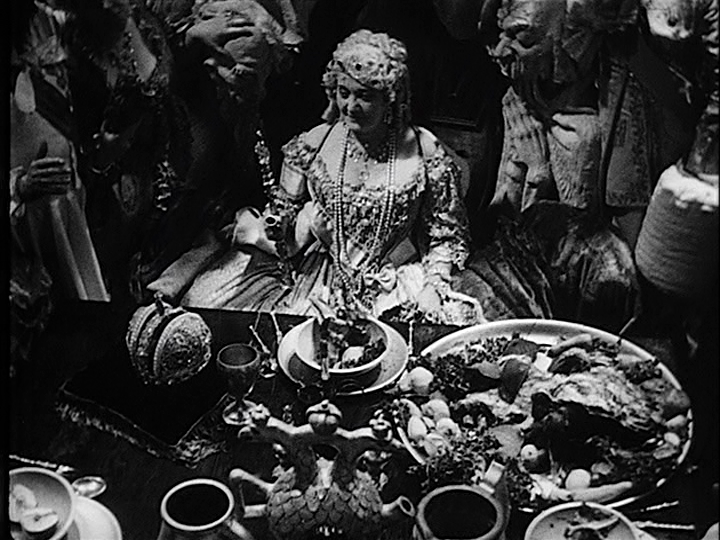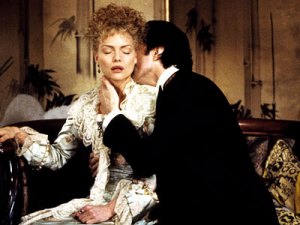This remains one of the most controversial reviews I ever published in the Chicago Reader (it ran in their September 17, 1993 issue) — occasioning many outcries, especially for my use of the term “drooling paisan” (although many others also quarreled with my point about apostrophes). No one, however, seemed to have had any quarrels with my treatment of Edith Wharton. — J.R.
THE AGE OF INNOCENCE
Directed by Martin Scorsese
Written by Jay Cocks and Scorsese
With Daniel Day-Lewis, Michelle Pfeiffer, Winona Ryder, Stuart Wilson, Miriam Margolyes, Geraldine Chaplin, Mary Beth Hurt, and Norman Lloyd.
Martin Scorsese clearly intends The Age of Innocence — his close adaptation of Edith Wharton’s 1920 novel about wealthy New York society in the 1870s — to earn him a bouquet of Oscars. But the high literary tone was somewhat blown for me by the opening title, immediately following a lush credits sequence of flower blossoms unfurling behind dainty fabric: “New York City, the 1870’s.” That superfluous apostrophe doesn’t exactly inspire confidence that Scorsese is the ideal interpreter of Edith Wharton.
Fortunately the movie improves after that, but never to the point that one can entirely forget that slip at the beginning. If the project winds up a noble failure, testifying throughout to Scorsese’s resourcefulness in plowing through an impossible mission — much better to my taste than Cape Fear, and considerably more likable (if less successful) than GoodFellas — it may be because the subject is diametrically opposed to what he usually does best as a filmmaker. I had assumed that the Visconti of The Leopard would be Scorsese’s key model; 15 minutes into the movie, I realized that Welles’s The Magnificent Ambersons was exerting an even stronger influence. But the fact remains that Welles — and Booth Tarkington (the author of Ambersons), Visconti, and Giuseppe Tomasi (the author of The Leopard) — are all better equipped to understand Wharton’s world, by virtue of their upper-class backgrounds, than Scorsese is. Even a bourgeois type like Antonioni seems better suited to capture the faint tremors and enduring ambiguities of Wharton’s fiction.
Perhaps the tribalism of the New York families is what attracted Scorsese’s interest — a thematic concern that supposedly makes this film the blood brother (if not the blood sister) of Mean Streets, Raging Bull, and GoodFellas. That, at any rate, is cowriter Jay Cocks’s suggestion as to why he brought this novel to Scorsese’s attention. But even if one accepts the loose connection between Wharton and Scorsese as ethnographers of their different tribes, that doesn’t mean that either one is qualified to comment on the other’s territory. If Wharton were alive and working today as a filmmaker, would Cocks have suggested she make a movie about macho rituals among working-class Italian Americans?
Scorsese’s street-smart, Little Italy origins are no disgrace; they simply point his perceptions in a certain direction. But trying to focus on Wharton’s world inevitably places him in the role of a drooling paisan with his nose pressed against the window. It’s one thing for Wharton, in the midst of a 362-page novel, to describe a dinner that Newland Archer, the lawyer hero, shares with his employer: “after a velvety oyster soup came shad and cucumbers, then a young broiled turkey with corn fritters, followed by a canvas-back with currant jelly and a celery mayonnaise.” But it’s quite another for Scorsese, in a 133-minute movie, to highlight each of these items in a separate decorously lit and framed shot. The novel is already consumerist, to be sure — Wharton’s method of mainstreaming Henry James is very much a matter of simplifying the style and amplifying the set decoration — but what figures as a fleeting aside in her prose becomes a TV ad for Gourmet magazine in the movie.
Much later in the film, after Archer is married and he and his wife are giving their first big dinner party, there’s an elaborate camera movement to set the scene that seems to come straight out of Sternberg’s The Scarlet Empress — an overhead pan up the laden banquet table to Archer at the head of it, then a backward track past the same opulent array of foodstuffs, then a crane up and away from the end of the table. In Sternberg’s movie, the point of such a show-off maneuver is the spectacle of conspicuous consumption at the court of Catherine the Great. But in Scorsese’s movie the key point is supposed to be Archer’s inability to communicate more than superficially with the woman he secretly loves, whose farewell party this is, before she returns to Europe. (“He was a prisoner in the center of an armed camp,” says the offscreen narrator.) Both conspicuous consumption and private grief are articulated in this scene, but given the studied grandiloquence of the opening it’s the former that takes the upper hand, overwhelming the dramaturgy. Thanks to this kind of emphasis there’s a lot to “ooo” and “ahh” at in this movie, but much less to sink your teeth into, and still less to think about afterward.
Let’s start with the overhead shots. Scorsese cuts to these distracting angles in two early scenes, at a ball and at another fancy dinner party, and both times the sudden shift in viewpoint doesn’t correspond to a dramatic or analytic point; it’s the nervous tic of an awed director who isn’t entirely sure what to do with his camera in relation to a scene but likes the visual pattern yielded by a bird’s-eye perspective on all this splendor. There’s nothing criminal about these cuts if mannerist doodling is all that’s intended, but I don’t think it would be an exaggeration to say that Welles or Visconti wouldn’t dream of such a shot unless it corresponded to some narrative or dramatic advancement.
Then there’s the film’s boldest and in some ways most interesting narrative device: the copious use of an offscreen female narrator (Joanne Woodward) to siphon large chunks of Wharton’s prose into the movie. This has the virtue of providing all sorts of background, social, and psychological details that would have been difficult to shoehorn into the action or dialogue; it also carries the special advantage of supplying Wharton’s own voice as a storyteller.
But deliberately or not, this device highlights a limitation in the novel, a limitation that reveals Wharton as far from the feminist writer she’s sometimes cracked up to be. The perspective expressed in Woodward’s narration, for all its knowingness about the inner workings of New York society in the late 19th century, is still fundamentally and strategically limited: these are the perceptions of a man, the hero Newland Archer. And in Jamesian fashion, everything he doesn’t understand, or can only guess at, becomes an ironic subtext to the narration.
To some extent this subtext in the novel indicts Archer, implying that his failure to act on his romantic impulses — to have an affair with Countess Ellen Olenska (Michelle Pfeiffer), the married cousin of his fiancee (and later wife) May Welland (Winona Ryder) — is as much a failure of nerve and backbone as it is a consequence of societal pressures. As Edmund Wilson (who incidentally regarded The Age of Innocence as a novel written on the very cusp of Wharton’s decline) put it in 1947, reviewing an early Wharton biography: “The male type which most conspicuously recurs in her novels is the cultivated intelligent man who cannot bear to offend social convention, the reformer who gets bribed without knowing it in marrying a rich wife, the family man who falls in love with someone more exciting than his wife but doesn’t have the courage of his passion; and the treatment of these characters by the author, though outwardly sympathetic, is always well chilled with an irony that has an undercurrent of scorn.”
But in the movie — where the narration has necessarily become a series of footnotes, and where romantic dreamboat Daniel Day-Lewis is cast as Archer — this element of scorn has been muted almost to the vanishing point. Novel and movie alike imply that a feminine conspiracy between May and Ellen (whose pivotal meetings are kept offstage in both) aborts the affair — a conspiracy (or at least complicity) Wharton doesn’t choose to describe, much less examine, though a truer feminist might have shown greater interest in the female perspective. And the suggestions of that conspiracy necessarily become far more prominent in the movie.
The reasons are gender-specific. In the novel, Wharton’s irony resides in the fact that, though she is deliberately restricting her viewpoint to Archer’s, she herself knows a little more than he does about the world he inhabits, and especially the world of Ellen and May. In the movie this “extra” knowledge, insofar as it exists, is restricted to Woodward’s voice, which can’t be equated with Scorsese’s “voice” as a filmmaker: he may know a little more than Archer does, but what he knows is exclusively what he’s gleaned from Wharton, and everything else is a massive, uncritical identification with Archer’s poignant sense of loss. The partial blame placed on New York’s upper-crust tribalism is certainly present in the novel, but such blame also figures as one of Archer’s alibis to himself about not following through on his love for Ellen. In the movie it’s no longer an alibi but the unvarnished explanation.
Despite these misgivings, it would be wrong to overlook Scorsese’s inventiveness and energy in The Age of Innocence, even if they’re more apparent at the margins of this story than at the center. He’s bold enough to resort to quick cutting in many scenes, though most directors avoid this technique for the sake of simplicity when working in ‘Scope, and he often creates a style of stenographic notation in crowded, busy scenes that shows off his staccato filmmaking manner at its best. He gives more attention than usual to color, creating a fine, burnished image of Ellen standing on a dock in Newport as seen from afar by Archer (a key moment in the book and film alike) and employing striking color fades (such as a “yellow-out” from a shot of yellow roses). There are evocative exterior shots of New York and its environs as they were supposed to look in the 1870s, some of which recall the re-creations of the midwest at a slightly later period in Ambersons, and dreamy, lush camera movements across richly upholstered interiors that treat us to comparably thought-out period inventories. The historical tidbits used in the narration are fascinating and well chosen, as are the paintings that occasionally punctuate the action.
I wish I could say that these and other touches yield a coherent historical meditation along the lines of Kubrick’s Barry Lyndon, either about the remote past or (by way of implied parallels) about the present, but if such an intention lies at the heart of this project, I have to confess it eluded me. Pfeiffer is luminous and multifaceted as Ellen, and Day-Lewis brings all the bemused elegance one could wish to the part of Archer. If Ryder, for all her resourcefulness, fares less well in a part that seems “underscripted” even in the novel, one should add that Scorsese and Cocks have still done their damnedest to incorporate as much of Wharton’s material about her as possible. (The film’s fleeting references to Archer’s previous adulterous affair pose a similar problem: much of the movie’s reticence on this matter can be traced back to Wharton.) All that’s really missing from the film is the kind of unifying vision and strategy that gave the novel purpose — which means that all that remains are scintillating commentaries about a story Scorsese never quite gets around to telling.











